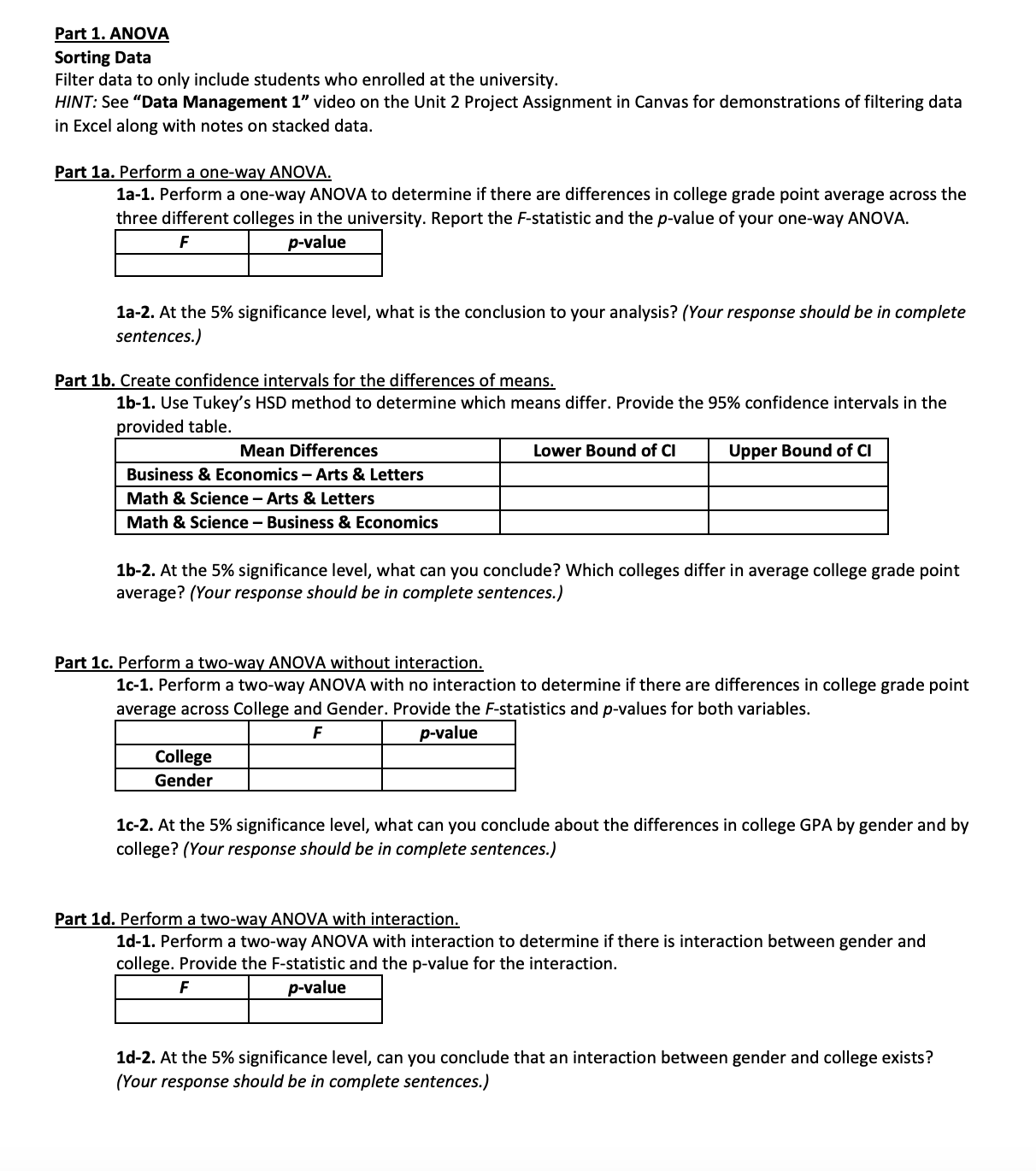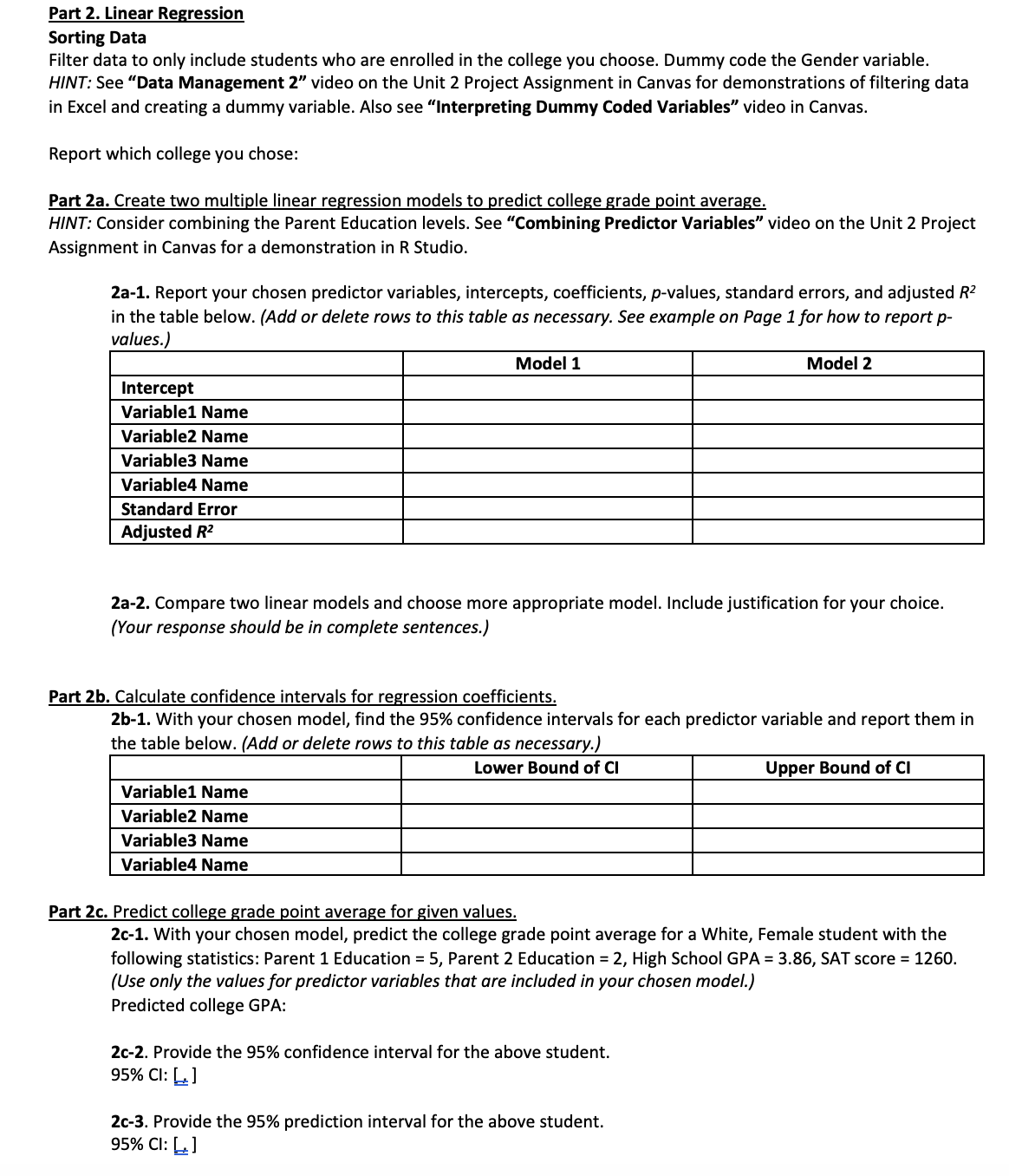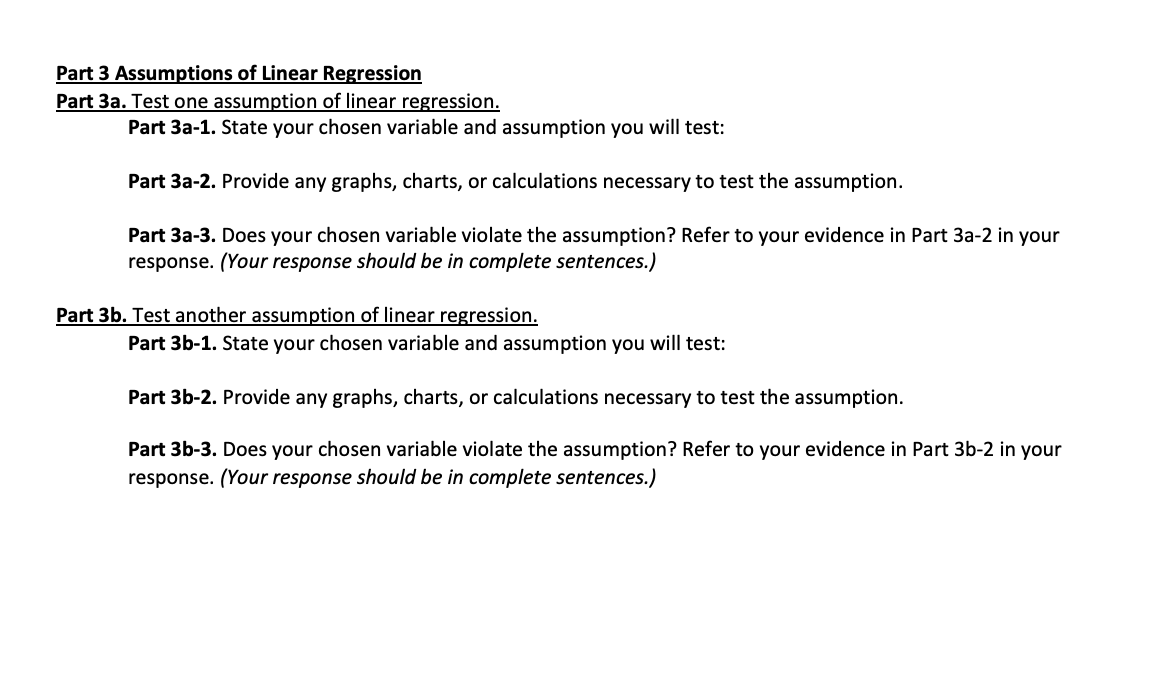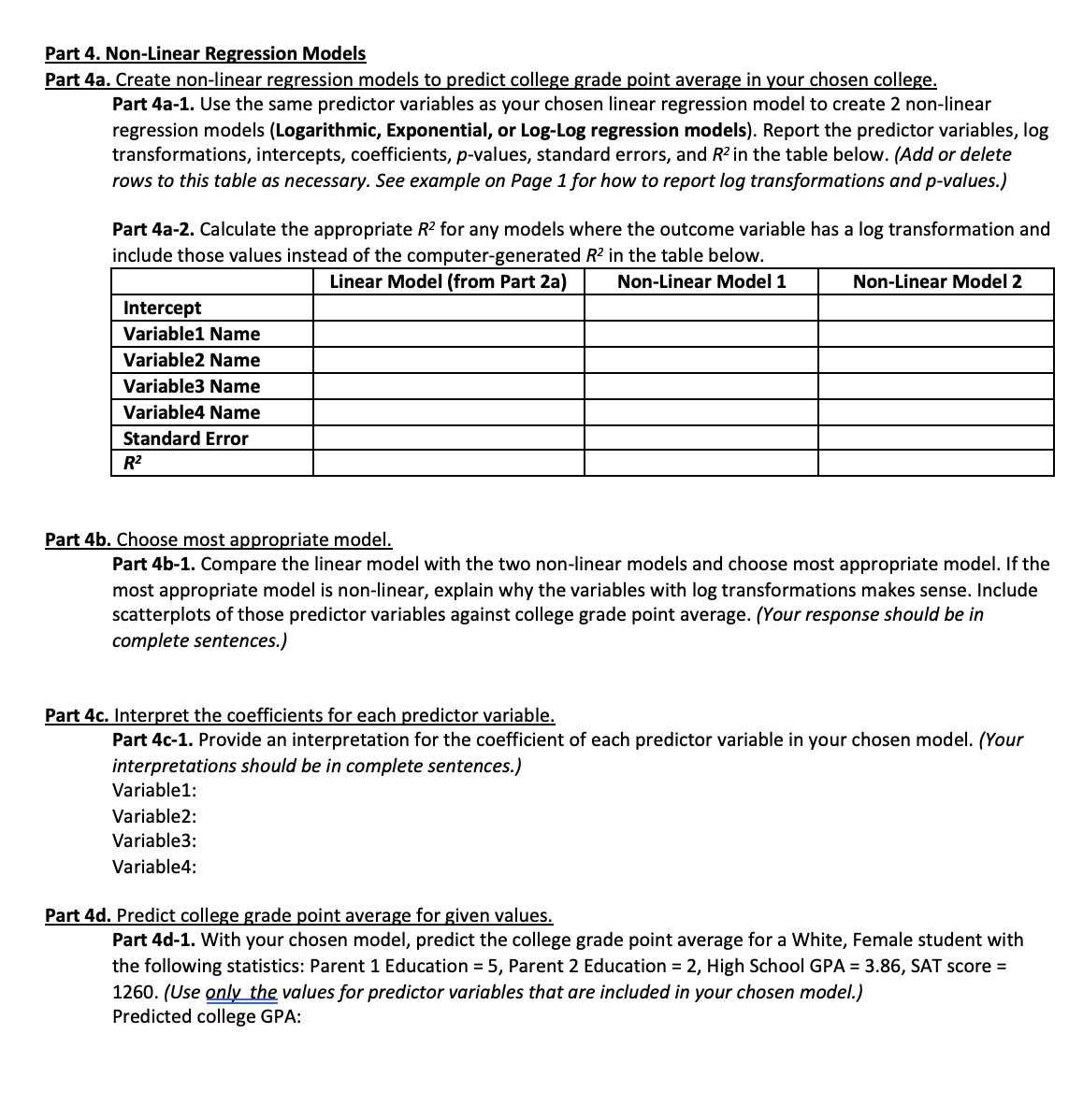Answered step by step
Verified Expert Solution
Question
1 Approved Answer
Part 1. ANOVA Sorting Data Filter data to only include students who enrolled at the university. HINT: See Data Management 1 video on the




Part 1. ANOVA Sorting Data Filter data to only include students who enrolled at the university. HINT: See "Data Management 1" video on the Unit 2 Project Assignment in Canvas for demonstrations of filtering data in Excel along with notes on stacked data. Part 1a. Perform a one-way ANOVA. 1a-1. Perform a one-way ANOVA to determine if there are differences in college grade point average across the three different colleges in the university. Report the F-statistic and the p-value of your one-way ANOVA. F p-value 1a-2. At the 5% significance level, what is the conclusion to your analysis? (Your response should be in complete sentences.) Part 1b. Create confidence intervals for the differences of means. 1b-1. Use Tukey's HSD method to determine which means differ. Provide the 95% confidence intervals in the provided table. Mean Differences Business & Economics - Arts & Letters Lower Bound of CI Upper Bound of CI Math & Science - Arts & Letters Math & Science - Business & Economics 1b-2. At the 5% significance level, what can you conclude? Which colleges differ in average college grade point average? (Your response should be in complete sentences.) Part 1c. Perform a two-way ANOVA without interaction. 1c-1. Perform a two-way ANOVA with no interaction to determine if there are differences in college grade point average across College and Gender. Provide the F-statistics and p-values for both variables. College Gender F p-value 1c-2. At the 5% significance level, what can you conclude about the differences in college GPA by gender and by college? (Your response should be in complete sentences.) Part 1d. Perform a two-way ANOVA with interaction. 1d-1. Perform a two-way ANOVA with interaction to determine if there is interaction between gender and college. Provide the F-statistic and the p-value for the interaction. F p-value 1d-2. At the 5% significance level, can you conclude that an interaction between gender and college exists? (Your response should be in complete sentences.) Part 2. Linear Regression Sorting Data Filter data to only include students who are enrolled in the college you choose. Dummy code the Gender variable. HINT: See "Data Management 2" video on the Unit 2 Project Assignment in Canvas for demonstrations of filtering data in Excel and creating a dummy variable. Also see "Interpreting Dummy Coded Variables" video in Canvas. Report which college you chose: Part 2a. Create two multiple linear regression models to predict college grade point average. HINT: Consider combining the Parent Education levels. See "Combining Predictor Variables" video on the Unit 2 Project Assignment in Canvas for a demonstration in R Studio. 2a-1. Report your chosen predictor variables, intercepts, coefficients, p-values, standard errors, and adjusted R in the table below. (Add or delete rows to this table as necessary. See example on Page 1 for how to report p- values.) Intercept Variable1 Name Model 1 Model 2 Variable2 Name Variable3 Name Variable4 Name Standard Error Adjusted R 2a-2. Compare two linear models and choose more appropriate model. Include justification for your choice. (Your response should be in complete sentences.) Part 2b. Calculate confidence intervals for regression coefficients. 2b-1. With your chosen model, find the 95% confidence intervals for each predictor variable and report them in the table below. (Add or delete rows to this table as necessary.) Variable1 Name Variable2 Name Lower Bound of CI Upper Bound of CI Variable3 Name Variable4 Name Part 2c. Predict college grade point average for given values. 2c-1. With your chosen model, predict the college grade point average for a White, Female student with the following statistics: Parent 1 Education = 5, Parent 2 Education = 2, High School GPA = 3.86, SAT score = 1260. (Use only the values for predictor variables that are included in your chosen model.) Predicted college GPA: 2c-2. Provide the 95% confidence interval for the above student. 95% CI:] 2c-3. Provide the 95% prediction interval for the above student. 95% CI:] Part 3 Assumptions of Linear Regression Part 3a. Test one assumption of linear regression. Part 3a-1. State your chosen variable and assumption you will test: Part 3a-2. Provide any graphs, charts, or calculations necessary to test the assumption. Part 3a-3. Does your chosen variable violate the assumption? Refer to your evidence in Part 3a-2 in your response. (Your response should be in complete sentences.) Part 3b. Test another assumption of linear regression. Part 3b-1. State your chosen variable and assumption you will test: Part 3b-2. Provide any graphs, charts, or calculations necessary to test the assumption. Part 3b-3. Does your chosen variable violate the assumption? Refer to your evidence in Part 3b-2 in your response. (Your response should be in complete sentences.) Part 4. Non-Linear Regression Models Part 4a. Create non-linear regression models to predict college grade point average in your chosen college. Part 4a-1. Use the same predictor variables as your chosen linear regression model to create 2 non-linear regression models (Logarithmic, Exponential, or Log-Log regression models). Report the predictor variables, log transformations, intercepts, coefficients, p-values, standard errors, and R2 in the table below. (Add or delete rows to this table as necessary. See example on Page 1 for how to report log transformations and p-values.) Part 4a-2. Calculate the appropriate R for any models where the outcome variable has a log transformation and include those values instead of the computer-generated R2 in the table below. Intercept Linear Model (from Part 2a) Non-Linear Model 1 Non-Linear Model 2 Variable1 Name Variable2 Name Variable3 Name Variable4 Name Standard Error R Part 4b. Choose most appropriate model. Part 4b-1. Compare the linear model with the two non-linear models and choose most appropriate model. If the most appropriate model is non-linear, explain why the variables with log transformations makes sense. Include scatterplots of those predictor variables against college grade point average. (Your response should be in complete sentences.) Part 4c. Interpret the coefficients for each predictor variable. Part 4c-1. Provide an interpretation for the coefficient of each predictor variable in your chosen model. (Your interpretations should be in complete sentences.) Variable1: Variable2: Variable3: Variable4: Part 4d. Predict college grade point average for given values. Part 4d-1. With your chosen model, predict the college grade point average for a White, Female student with the following statistics: Parent 1 Education = 5, Parent 2 Education = 2, High School GPA = 3.86, SAT score = 1260. (Use only the values for predictor variables that are included in your chosen model.) Predicted college GPA:
Step by Step Solution
There are 3 Steps involved in it
Step: 1

Get Instant Access to Expert-Tailored Solutions
See step-by-step solutions with expert insights and AI powered tools for academic success
Step: 2

Step: 3

Ace Your Homework with AI
Get the answers you need in no time with our AI-driven, step-by-step assistance
Get Started


